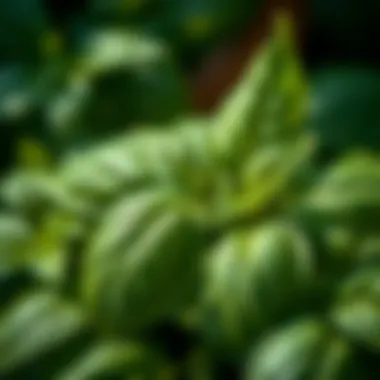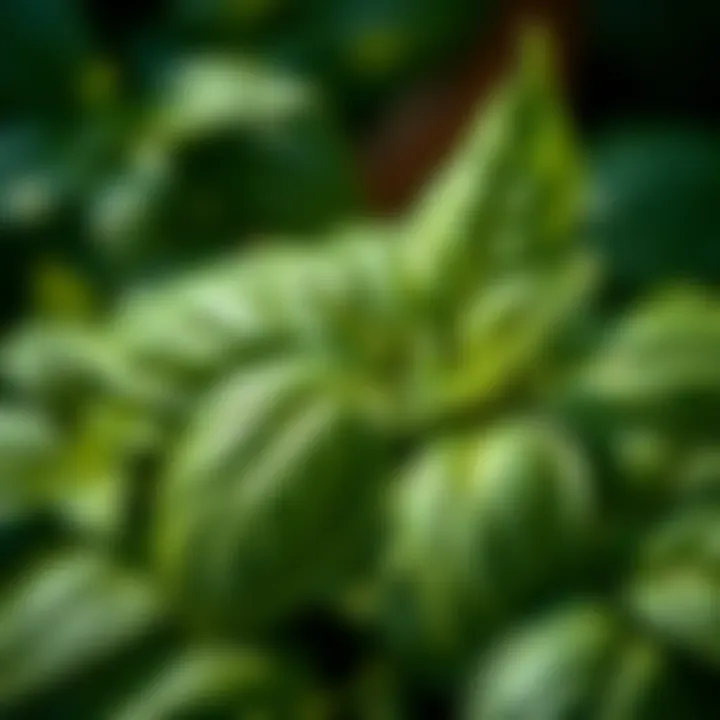Exploring Popular Herbs: Uses, Benefits, and Cultivation


Intro
Herbs have found their way into the human experience for thousands of years, serving purposes that extend far beyond mere flavoring of food. These plants hold a treasure trove of benefits, influencing not only culinary practices but also medicinal uses, cultural traditions, and even ecological balance. In this article, we delve into the fascinating world of popular herbs, laying bare their uses and advantages, while offering practical insights for those who wish to cultivate them. Garden enthusiasts and culinary artists alike can gain invaluable knowledge of these verdant neighbors.
Not all herbs are created equal; each comes with its own unique history, growth habits, and contributions to both our wellbeing and the environment. By steering through the lush landscape of herbology, we shall explore how these plants have interwoven into the very fabric of human health and culinary arts, providing a harmonious blend of information and actionable guidance for everyone from novice gardeners to seasoned chefs.
Which herbs should you consider for your garden? What are the core advantages of using these plants in your day-to-day life? From the potent antiseptic properties of thyme to the comforting embrace of chamomile, understanding the role of each herb can elevate both your health and culinary creations to new heights. Together, let’s chart a course through this aromatic territory and uncover how engaging with these plants can bless our lives, gardens, and kitchens.
Forest Ecology and Biodiversity
Importance of Forest Ecosystems
Before diving into the culinary and medicinal aspects of herbs, it’s crucial to appreciate the broader ecological frameworks within which these plants thrive. Forest ecosystems play an integral role in supporting biodiversity, with herbs serving as essential components of these habitats. They not only contribute to the diversity of life finding shelter in the woods, but they also participate actively in nutrient cycling and soil health.
The complexity of these systems is astounding. Trees, shrubs, and herbs interact in intricate ways, forming layers of foliage that create unique microclimates. This layering allows for a variety of herbaceous plants to flourish in the understory where light and moisture conditions vary greatly.
Flora and Fauna in Woodlands
Certain herbs are often synonymous with specific forest types. For instance, wild garlic, found across European woodlands, is well-regarded for its flavor and health benefits. In contrast, the Eastern red cedar might host a variety of unique herbaceous plants that take advantage of its shade.
"The health of forest ecosystems is intertwined with the survival of myriad herbaceous plants that offer countless benefits to humans and wildlife alike."
These plants also serve as vital food for numerous species, from deer to various insect populations. Recognizing this interdependence can help community leaders and gardening enthusiasts to advocate for the preservation and cultivation of native herb species, thus fostering a resilient ecosystem.
Sustainable Practices in Herb Cultivation
Techniques for Responsible Management
With growing concerns about environmental degradation and loss of biodiversity, it's becoming increasingly important to implement sustainable practices in herb cultivation. This includes using organic methods, such as composting and employing natural pest control techniques, to minimize chemical runoff into surrounding ecosystems. Herb subdivisions in forests can be carefully monitored to ensure that their extraction does not lead to a collapse of local populations.
Certification Schemes and Standards
Communities are also adopting certification schemes that emphasize sustainable and ethical practices in both wild-harvesting and cultivation. For example, organizations like the Forest Stewardship Council and Rainforest Alliance promote certification for sustainably produced herbs, providing consumers with verification that their purchases support environmental health.
Community Engagement and Stewardship
Role of Local Communities
Grassroots initiatives, led by local communities, represent a proactive approach towards herb conservation. These groups often host workshops to educate fellow residents about the benefits and cultivation of local plants, fostering a sense of ownership over shared natural resources. Promoting awareness about the medicinal properties of local herbs encourages community interest in preserving indigenous plant life, which should never be underestimated.
Volunteer Opportunities for Engagement
For those looking to immerse themselves further, many organizations seek volunteers to assist in planting, maintaining herb gardens, or participating in educational outreach. These opportunities not only deepen understanding of herbs but reinforce community bonds—enhancing social capital while providing important ecological education to all involved.
Preamble to Popular Herbs
Herbs have a long-standing relationship with human civilization, threading their way through our kitchens, gardens, and medicinal practices. The increasing interest in health and wellness has sparked a renewed focus on these often overlooked plants. Incorporating popular herbs into everyday life presents not only culinary delights but also numerous health benefits that should not be underestimated. This section serves to coordinate understanding, appreciating how these plants can enhance both our meals and our well-being.
Definition and Overview
Popular herbs are largely defined as aromatic plants used mainly for flavoring, fragrance, or medicinal properties. These plants, such as basil, thyme, and rosemary, have become staples in kitchens worldwide, thanks to their ability to elevate a dish from mundane to extraordinary. Not just for culinary uses, many herbs serve as natural remedies, offering varied health benefits ranging from immune support to digestive aid.
The cultivation of herbs is often straightforward, making them accessible even to novice gardeners. Most culinary herbs thrive in well-drained soil and require moderate sunlight, allowing for flexibility in where they can be grown.
To grow herbs effectively, one can choose between potting them indoors or establishing a dedicated herb garden outdoors. Each method has its considerations, such as pest control and seasonal weather effects.
"Herbs are the unsung heroes of both the kitchen and the pharmacy. They offer solutions that are natural and often more affordable than commercial alternatives."
Historical Significance of Herbs
Throughout history, herbs have been revered not solely for their flavors but also for their symbolic meanings and therapeutic capabilities. Ancient civilizations utilized herbs in various ways; Egyptians often included them in their embalming rituals while Greeks and Romans used them in culinary practices as well as for health. In herbalism, the historical significance lies deeper in foundational practices that shaped our understanding of natural medicine.


Traditional systems of medicine, such as Ayurveda and Traditional Chinese Medicine, rely heavily on herbs for enhancing wellness and preventing illness. Interestingly, some herbs have also been associated with cultural rites, belief systems, and rituals, making them integral to the human experience.
Overall, the journey through the world of herbs reveals their multifaceted roles; not only do they nourish our body in a literal sense, but they are also entwined in our social fabric, cultural practices, and historical timelines. Understanding the importance of these plants sets the stage for deeper exploration into their culinary uses, health benefits, and—indeed—the art of cultivation.
Culinary Herbs
In the culinary world, herbs serve more than just a flavor enhancer; they are the backbone of countless dishes across various cultures. Culinary herbs not only elevate the taste of food but also bring a plethora of health benefits. Utilizing herbs in cooking can transform mundane ingredients into an unforgettable meal. The addition of these greens can provide not only aromatic quality but also a wide array of vitamins, antioxidants, and anti-inflammatory properties. Understanding and utilizing culinary herbs allows one to appreciate their profound ability to impact not only our meals but our overall health.
Basil: The Versatile Kitchen Staple
Basil is often referred to as the king of herbs, known for its aromatic leaves and bold flavor. This herb is prominent in diverse cuisines, especially in Italian dishes such as pasta sauces and pesto. It can also add a refreshing bite to salads or a rich taste to soups. Aside from its culinary uses, basil is worth noting for its health benefits as well. It contains essential oils that can aid digestion and has properties that might help lower stress levels.
When cultivating basil, it’s beneficial to choose a spot that receives full sun and well-drained soil. Frequent trimming not only encourages bushy growth but also enhances its flavor. Basil is generally considered easy to grow, making it a favorite among home gardeners.
Thyme: A Fragrant Companion
Thyme is an herb that's often overlooked, but its subtle yet distinctive flavor can elevate a dish significantly. Popular in Mediterranean cooking, thyme pairs excellently with meats, vegetables, and soups. It has a strong aromatic presence that can bring warmth to roasted dishes and complements other herbs well. This humble herb is also recognized for its antiseptic properties and might support respiratory health.
Thyme prefers a sunny position with well-drained soil, similar to other culinary herbs. Regular trimming helps maintain a compact plant and promotes new growth. It’s also a perennial herb, which means that once established, it can return year after year, providing flavors to meals without the need for replanting.
Rosemary: A Warm Aroma
Rosemary is known for its pine-like flavor, which can invoke a sense of hearty comfort in many dishes. Typically used with meats, especially lamb and poultry, it adds an aromatic zest that enhances the overall taste. The health benefits of rosemary are often highlighted in holistic practices, believed to improve memory and digestion.
In terms of cultivation, rosemary thrives in Mediterranean-style conditions: hot, dry, and sunny. It requires little water, making it easy to maintain, and it can grow into a beautiful, hardy shrub if cared for properly. The leaves can be used fresh or dried, making this herb a valuable addition to any kitchen.
Mint: The Refreshing Herb
Mint has a unique freshness that can transform both drinks and dishes alike. Used in beverages, salads, and desserts, mint brings a refreshing twist to recipes. The leaves contain cooling properties and are often used to promote digestion and soothe stomach issues. Mint tea is particularly well-known for its ability to calm and refresh.
When planting mint, it’s wise to use pots or containers since it can grow aggressively and take over a garden bed. This herb likes moist, rich soil and partial shade, making it versatile for various garden setups. Regular harvesting encourages new growth, making mint a fast and rewarding plant to cultivate.
Sage: Culinary and Medicinal Uses
Sage, with its earthy, slightly peppery flavor, has long been valued in kitchens. It’s particularly recognized for its role in stuffing for poultry and in rich, creamy sauces. Beyond culinary uses, sage has notable medicinal properties. Traditionally it’s been used to help promote mental clarity and improve digestive health.
Sage thrives in full sun and is particularly hardy. It prefers poor to average soil, which can make it an easy herb to grow. Its silvery-green leaves not only provide culinary benefits but also aesthetic charm to any herb garden. Pruning helps in maintaining the plant's structure and encourages fresh growth.
"Incorporating these culinary herbs into your diet can not only elevate flavors but also enhance your dining experience."
Culinary herbs are essential components that contribute to the richness of our cuisines and our health. Each herb has its own unique properties, flavors, and cultivation needs. Understanding these elements allows both culinary enthusiasts and anyone looking to improve their health to harness their full potential.
Medicinal Herbs
Medicinal herbs hold a significant place in this article, tapping into the age-old relationship humans have with plants for health and wellness. These botanicals go beyond mere culinary delights; they are essential components in traditional medicine and modern healthcare. Understanding medicinal herbs can help individuals harness their potential for promoting health, preventing illness, and supporting overall well-being. It’s like having a natural pharmacy right in your backyard.
Herbs such as Echinacea and Ginger showcase the wealth of benefits that exist in nature. They are not just pretty decoration in the garden; they cater to specific ailments and bolster the immune system. This section will explore various medicinal herbs, exposing their unique properties, methods of application, and cultivation insights.
Echinacea: Immune Booster
Echinacea is renowned for its immune-enhancing properties. Often dubbed the "Coneflower," this herb has been widely used to prevent colds and reduce flu symptoms. Evidence suggests that it may help increase the production of white blood cells, enabling the body to effectively combat infections. With several species available, Echinacea purpurea is the most commonly cultivated for medicinal use.
Growing Echinacea is relatively straightforward, as they are drought-resistant and thrive in sunny locations. Although they prefer well-drained soil, you should ensure adequate spacing for airflow to reduce disease chances. Regular pruning promotes healthy growth and blossoms, while harvesting the flowers and roots at the peak of their potency optimizes their benefits.
Ginger: The Root of Relief
The zesty rhizome has earned a prominent spot in herbal medicine. Ginger has a long-standing reputation for alleviating nausea, reducing inflammation, and promoting digestion. Many households keep ginger on hand for its ability to soothe upset stomachs or to add a kick to meals.
Cultivating ginger is a rewarding experience. It requires a warm, humid climate to flourish. Start with a fresh ginger root with visible bud eyes. Plant it in rich soil, and observe as it sprouts into a lush green plant. Regular watering is essential, but overwatering can lead to root rot—so it’s a delicate balance. Harvesting can be done as early as six months after planting; however, it's often best to allow the root to mature further for enhanced flavor and potency.
Lavender: A Soothing Essence
There's something undeniably calming about Lavender. This herb is not only a feast for the eyes with its stunning purple hues, but it also serves as a powerful relaxant. Research highlights that lavender scents can improve sleep quality, reduce anxiety, and promote general calmness.


Growing lavender is a delight. It favors well-draining soil and plenty of sun. Planting lavender in pots can enhance its growth, offering the flexibility to manage its environment better. Pruning is vital to ensure that the plants remain healthy and produce abundant blooms. Lavender thrives in dryer conditions, so be cautious with watering—better to err on the side of under than over.
Turmeric: The Golden Miracle
Turmeric has recently gained traction as a superfood, thanks to its active compound, curcumin. Renowned for its anti-inflammatory and antioxidant properties, turmeric is believed to play a role in preventing chronic diseases and promoting overall health.
Cultivating turmeric can be quite fulfilling, as it needs a warm climate and plenty of moisture. Begin with a rhizome root, and plant it in nutrient-rich soil with adequate sunlight. Harvesting usually occurs around 8 to 10 months after planting; however, the rhizomes should be left to mature fully for optimal flavor and effects. Note that turmeric stains easily, so handle with care.
St. John’s Wort: Natural Mood Enhancer
St. John’s Wort has long been used as a natural remedy for depression and emotional disturbances. Studies indicate that it may be comparable to conventional antidepressants for mild to moderate depression, while also exhibiting anti-inflammatory properties.
This herb is hardy and adaptable, thriving in various soil types as long as drainage is adequate. St. John’s Wort is a perennial, with golden-yellow flowers emerging in mid-summer. Regular harvesting of its blossoms maximizes potency. Be cautious, though, as this herb can interact with many medications, so consulting with a healthcare provider is essential before use.
"Herbs hold the potential to heal, yet they are often overlooked. Engaging with medicinal plants not only fosters better health but also strengthens our connection to nature."
Medicinal herbs indeed present a wealth of opportunities, not just for individual health but also for sustainable cultivation and the environment. As we delve deeper into each herb’s properties, gardening techniques, and health benefits, the versatility of these plants reveals itself. Their roles in human history and medicine are vast and ripe for exploration.
Cultivation and Gardening Practices
When delving into the world of herbs, understanding cultivation and gardening practices is crucial. This knowledge not only enhances the growth and quality of the herbs but also ties into sustainable practices that promote biodiversity and ecological health. As herbs are often used for culinary and medicinal purposes, their upbringing directly influences their potency and efficacy.
Choosing the Right Location
Selecting the appropriate location for your herb garden can make all the difference. Herbs thrive in well-draining soil, plenty of sunlight, and good airflow. When picking a site, consider these factors:
- Sun Exposure: Most culinary herbs prefer full sun, so at least six hours of direct sunlight is ideal. However, some, like mint, can tolerate partial shade.
- Access to Water: Having a nearby water source simplifies irrigation. Herbs do not like to sit in waterlogged soil, but they also need consistent moisture.
- Protection from Wind: A sheltered spot can prevent damage from strong gusts, which can cause wilting or even uprooting of delicate plants.
In many urban settings, utilizing vertical gardening or container gardening can compensate for limited space and sunlight. For instance, balcony herb gardens expose these plants to favorable light while conserving ground area.
Soil Preparation Techniques
Soil health is the backbone of successful herb cultivation. Preparation involves assessing and enhancing the growing medium to create an optimal environment. Here are some techniques:
- Testing the Soil: Analyze the soil for pH and nutrient levels. Herbs typically enjoy slightly acidic to neutral soil (pH 6.0 to 7.0).
- Amending the Soil: Incorporate organic matter such as compost or well-rotted manure. This not only provides nutrients but improves soil structure and drainage.
- Tilling: Loosen compacted soil using a spade or a tiller. This promotes root growth and allows for better nutrient uptake.
Ensuring good soil is akin to laying a strong foundation before building a house; it sets the stage for all that grows after.
Watering and Maintenance Strategies
Regular maintenance can mean the difference between a flourishing herb garden and a withered one. Understanding your herbs' water needs is paramount. Here’s how to manage this:
- Watering Schedule: Herbs generally need more water during dry spells but less as they reach maturity. Aim to water deeply once or twice a week rather than giving frequent, shallow waters.
- Mulching: Apply a layer of organic mulch around plants to retain moisture and suppress weeds.
- Observation: Pay close attention to your plants; yellowing leaves could indicate overwatering, while wilting shows a lack of moisture.
Maintaining a watchful eye gives you insight into your plants' health, enabling timely interventions.
Pest Management Approaches
Encountering pests is a natural occurrence in gardening, yet tackling them decisively is vital for protecting your herbs. Here are several effective strategies:
- Diverse Planting: Incorporating a variety of plants can prevent pest infestations. Companion planting creates an ecosystem that deters unwanted visitors. For example, planting basil near tomatoes can repel aphids.
- Natural Predators: Encourage beneficial insects such as ladybugs and hoverflies that feed on aphids and caterpillars. Creating habitats with flowering plants can attract these allies.
- Organic Solutions: Utilize neem oil or insecticidal soap as treatments when issues arise. These options are less harmful compared to chemical pesticides and can effectively mitigate infestations without jeopardizing beneficial insects.
"An ounce of prevention is worth a pound of cure."
Taking proactive steps to create a healthy and sustainable environment will yield dividends in the form of bountiful herbs. By adopting these cultivation practices, you ensure not just the survival of your herbs but also their quality and benefits for your culinary or medicinal use.
For more information on herb gardening best practices, you can visit reliable sources like USDA.gov or Extension.org.
Connecting these principles back to the broader theme of sustainable living allows us to embrace the full potential of our gardens. This not only nourishes our bodies but also our connection to the environment.
Herbs in Cultural Practices


Herbs have been pivotal to various cultural practices for centuries, serving not just a functional role, but also embodying significant cultural meanings. Their integration into different societies illustrates a tapestry of beliefs, traditions, and historical contexts, blending medicinal benefits with culinary delights. The exploration of herbs in cultural practices showcases their versatility and essential nature in humanity's development, informing everything from rituals to everyday cooking. When examining the importance of this topic, we must consider not only the pragmatic uses but also the profound connections established between herbs and the identities of communities.
Traditional Uses in Folk Medicine
Folk medicine often represents the earliest form of healthcare. Throughout history, herbs have played the role of natural healers in many cultures. In many indigenous communities, herbs are not simply remedies; they are seen as gifts from nature, endowed with powers to heal and protect. For instance, in traditional Chinese medicine, ginseng is highly valued for its ability to boost vitality and is often used to treat fatigue. Similarly, in the Andes, the use of coca leaves has deep roots in cultural practices—not just for its stimulant effects, but as a means to connect with ancestral traditions and the land itself.
Examples of traditional uses in various cultures include:
- Elderberry: Widely used among Native Americans, prized for its immune support.
- Willow bark: Traditional Europeans utilized it for pain relief centuries before modern aspirin was developed.
- Chamomile: Utilized in ancient Egypt for its calming effects, a testament to how plants hold centuries worth of wisdom.
Thus, herbs in folk medicine possess a rich heritage, transforming personal and communal rituals into episodes of healing and resilience.
"Plants are not just passive resources; they embody centuries of human experience, shaped by cultural contexts and medicinal practices."
Role in Culinary Traditions Across Cultures
The culinary landscape across cultures has been dramatically shaped by herbs. They bring various flavors, aromas, and colors, illuminating dishes while enhancing nutritional profiles. From the fragrant basil in Italian cuisine to cilantro in Mexican dishes, herbs define cultural gastronomy, reflecting local tastes and agricultural practices.
When examining their culinary roles, several aspects become evident:
- Flavor Enhancement: Herbs like parsley and basil enhance the palate, making even the simplest dishes more vibrant.
- Cultural Identity: Specific herbs often symbolize heritage, intertwining with local customs and ways of life. Think of the use of mint in Middle Eastern dishes—it embodies freshness that is synonymous with the region.
- Health Benefits: Many culinary herbs not only add flavor but also provide health advantages, such as slowing down inflammation or aiding digestion. For example, turmeric, often used in Indian cuisine, is celebrated for its anti-inflammatory properties.
Across continents, the use of herbs is a testament to collective memory, combining commerce, tradition, and nutrition—a narrative embedded in the very act of cooking. In sum, herbs serve as cultural ambassadors, bridging diverse gastronomic practices and healing traditions into a cohesive understanding of humanity’s relationship with nature.
Future Perspectives on Herb Usage
The exploration of future perspectives on herb usage provides invaluable insights into the evolving landscape of botanical applications. As we stand at the intersection of culinary innovation, sustainable agriculture, and holistic health practices, understanding future trends in herb usage becomes crucial. More than mere decoration on a plate, herbs are becoming pivotal in addressing various global challenges, particularly those related to food security, health, and environmental sustainability.
One key element to consider is the increasing push for sustainable harvesting practices. With rising concerns about over-harvesting and the depletion of wild herb populations, a shift toward sustainable methods is not just necessary but imperative. This involves adopting practices that respect both the environment and the communities that rely on these resources.
Among the benefits of sustainable harvesting are:
- Promotion of biodiversity: Sustainable practices help maintain the delicate balance within ecosystems.
- Economic viability for local communities: By prioritizing responsible harvesting, local populations can ensure the continued presence of herbs in their natural habitats while also supporting their livelihoods.
- Enhanced quality of herbs: Cultivating herbs with care often results in stronger flavor profiles and healthier plants.
Additionally, the development of innovations in herb cultivation holds promise in optimizing yield and minimizing environmental impact. Advanced techniques, such as vertical farming and hydroponics, allow for the cultivation of herbs in urban settings, where space may be limited. These methods not only conserve water but can also reduce the carbon footprint associated with transporting herbs from rural farms to urban kitchens.
Innovative practices being adopted include:
- Aeroponics: A method where herbs grow in a mist environment, significantly reducing both the need for soil and water.
- Genetic advancements: Scientists are exploring genetic modifications that could lead to more resilient herb variants, capable of withstanding pests and diseases without chemical interventions.
- Integrated Pest Management: Combining biological and ecological practices to control pests in a way that reduces reliance on synthetic pesticides.
"The future of herb usage lies not only in culinary applications but in their potential to sustain ecosystems and contribute to human well-being."
As we turn our eyes toward the future of herb usage, embracing these sustainable practices and innovations is vital. This offers a pathway to not only enhance our culinary landscapes but also to contribute positively to our ecosystem, making a lasting impact on global health and agriculture. By prioritizing sustainable methods and technological advancements, we can look forward to a future where herbs flourish alongside the communities that cultivate them.
The End
In wrapping up this exploration of the world of herbs, it's essential to reflect on their multifaceted roles in our lives. Herbs are not just a garnish on a plate or a component in a traditional remedy; they represent a bridge between culinary arts, holistic health, and sustainable practices. Their significance stretches back through history, and to this day, they continue to be fundamental to our culinary creations and well-being.
The summary of key points we’ve discussed provides a comprehensive view of the various popular herbs:
- Culinary herbs like Basil and Thyme enrich flavors while adding nutritional value to our meals.
- Medicinal herbs such as Echinacea and Lavender offer health benefits, often supporting our immune systems and promoting relaxation.
- Understanding cultivation practices allows garden enthusiasts to better care for these plants, encouraging earth-friendly gardening that respects the environment.
- Cultural practices highlight the rich traditions tied to herbs, illustrating how these plants have shaped culinary customs and folk medicines across diverse societies.
- The future of herbs includes sustainable harvesting and newer innovations in cultivation, suggesting a continual evolution in our relationship with these vital plants.
In essence, we must recognize that each herb carries stories, benefits, and cultural legacies that are inviting our exploration. Their uses can be both traditional and innovative, enhancing not only our plates but also our lives.
Summary of Key Points
To distill the information shared:
- Herbs play vital roles both in kitchen and health, encouraging a symbiosis between flavor and well-being.
- Each discussed herb carries unique benefits that can be leveraged in everyday life.
- Cultivation insights empower individuals to grow their own herbs, fostering a deeper connection with nature.
- The cultural context around herbs enhances global appreciation, connecting us with past traditions.
- Looking towards the future, sustainable practices ensure that herbs remain a resource for generations to come.
Encouragement Towards Personal Use of Herbs
Embarking on the journey to incorporate herbs into daily routines need not be daunting; it can be quite rewarding. Whether you’re a seasoned gardener or a casual cook, you should think about integrating these aromatic plants into your life. Start small, perhaps with a pot of basil on your kitchen windowsill or a mint plant on your patio. These simple actions not only elevate culinary experiences but also contribute to personal wellness.
Consider this an invitation to explore:
- Try your hand at growing medicinal herbs; chamomile and peppermint can easily thrive indoors.
- Experiment with culinary herbs in new recipes, adding a fresh twist to everyday meals.
- Dive into local communities or online forums to share experiences and tips on herb cultivation.
With each handful of fresh herbs, you connect with a broader ecosystem and embrace the benefits that these remarkable plants offer. By cultivating a personal herb garden or incorporating them into meals, you nourish not only yourself but also support sustainable practices that honor the environment. So, roll up your sleeves, and start your herb journey: the rewards are as rich as the flavors.















